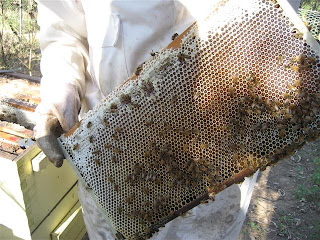.JPG)
The sun was out today and we were both home, so we took advantage of the break in weather (its been overcast and or rainy here for months) to check out our hives. We do try to get out there at least once a fortnight to take a look at them.
We also change over the small hive beetle traps we have set (pictured
ABOVE) that grate on the top is big enough for the beetles to crawl into the little trough held below it - which is filled with Diatematous Earth, which kills them but not the bees.
We have those in the honey box (the top box) between the frames and another 'mouse' type in the brood box (which is the name for the box on the bottom which contains the larvaes, the Queen and the drones.
.JPG)
Aside from checking and replacing the traps (which seem to be working well), we also use the time to check on the hive activity and health.
We also check to see when and if we need to do a honey harvest too.
.JPG)
This frame (
BELOW) is ready for harvesting - you can see the capped cells full of honey. Any frame with more than 3/4 covered in cappings is ready to harvest.
.JPG)
Just look at that golden honey with the sun behind it...
.JPG)
We haven't harvested from the bees for quite a while. This is because of the weather. They need sunny days to forage for pollen and nectar. When it's overcast and or rainy (as it has been here) they eat the honey, so harvesting from them is taking their food, which in turn will weaken the hive and we need them strong and healthy to fight the beetle.
Other beetle strategies include having our hives on gravel with weed mat under it (the beetles breed in soil) and also limeing the area around the hives - beetles don't like soil too alkaline (apparently).
But just like designing and maintaining a permaculture garden you need an integrated approach - not just one solution.
Seems to be working though, the number of beetles in our hives were reduced from the last time we checked them.
We're no experts in this, just willing to try different things and keep going with the things that seem to be working.
If you're thinking of getting bees, it pays to join your local beekeeping association and read as many good books as you can on how to care for them.
If this fine weather keeps up, we'll also be able to harvest honey soon too.
Cheers,
Sonya
The Novice Beekeeper
 We'll its been a while between posts but things have been going well with our small apiary.
We'll its been a while between posts but things have been going well with our small apiary. This means we can get the frames inside the house with no bees on them and no chance of us being stung.
This means we can get the frames inside the house with no bees on them and no chance of us being stung.





.JPG)
.JPG)
.JPG)
.JPG)
.JPG)
.JPG)
.JPG)
.JPG)
.JPG)
.JPG)
.JPG)
.JPG)
.JPG)
.JPG)
.JPG)
.JPG)
.jpg)
.JPG)
.JPG)
.JPG)
.JPG)
.JPG)
.JPG)
.JPG)
.JPG)
.JPG)
.JPG)
.JPG)